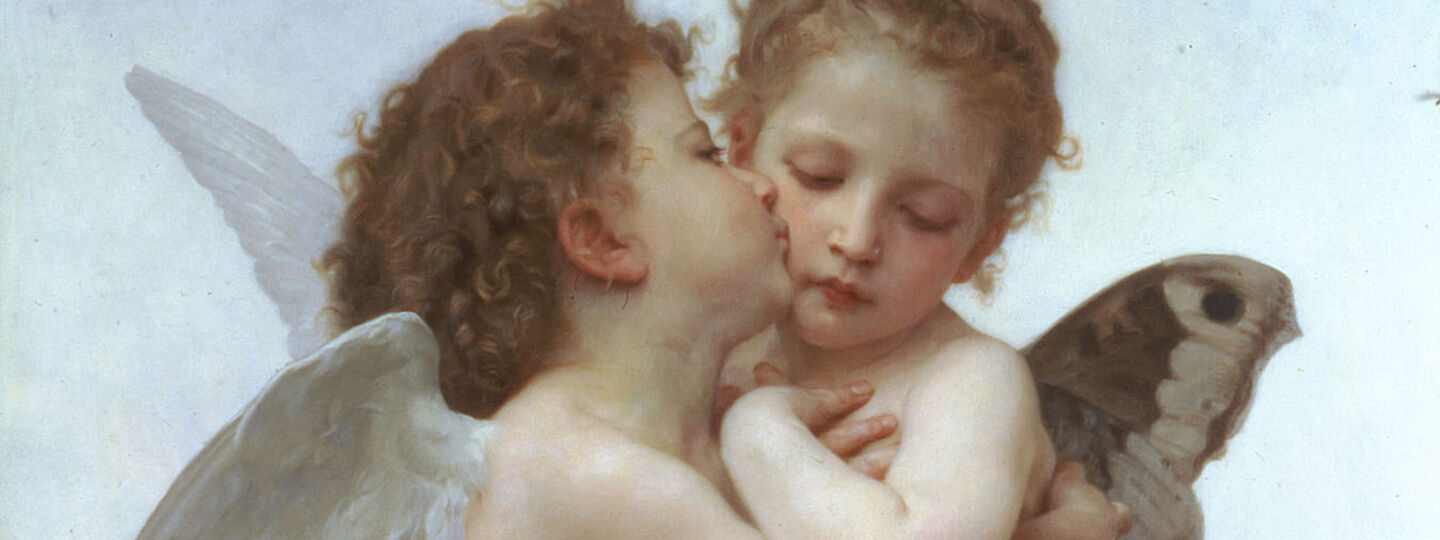
Info
Amor y psique, niños
William-Adolphe Bouguereau
1890
Private Collection
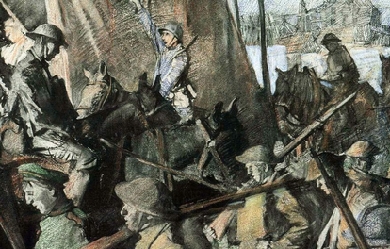
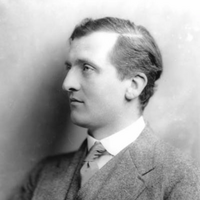
Thomas Ernest Hulme (16 September 1883– 28 September 1917) was an English critic and poet who, through his writings on art, literature and politics, had a notable influence upon modernism. He was an aesthetic philosopher and the 'father of imagism’. Early life Hulme was born at Gratton Hall, Endon, Staffordshire, the son of Thomas and Mary Hulme. He was educated at Newcastle-under-Lyme High School, and from 1902, St John’s College, Cambridge, where he read mathematics, but was sent down in 1904 after rowdy behaviour on Boat Race night. He was thrown out of Cambridge a second time after a scandal involving a Roedean girl. He returned to his studies at University College, London before travelling around Canada and spending time in Brussels acquiring languages. Proto-modernist From about 1907 Hulme became interested in philosophy, translating works by Henri Bergson and sitting in on lectures at Cambridge. He translated Georges Sorel’s Reflections on Violence. The most important influences on his thought were Bergson, who asserted that 'human experience is relative, but religious and ethical values are absolute’ and, later, Wilhelm Worringer (1881–1965), German art historian and critic - in particular his Abstraktion und Einfühlung (Abstraction and Empathy, 1908). Hulme was influenced by Remy de Gourmont’s aristocratic concept of art and his studies of sensibility and style. From 1909 Hulme contributed critical articles to The New Age, edited by A. R. Orage. Hulme developed an interest in poetry and wrote a small number of poems. He was made secretary of the Poets’ Club, attended by such establishment figures as Edmund Gosse and Henry Newbolt. There he encountered Ezra Pound and F. S. Flint. In late 1908 Hulme delivered his paper A Lecture on Modern Poetry to the club. Hulme’s poems Autumn and City Sunset, both published in 1909 in a Poets’ Club anthology, have the distinction of being the first Imagist poems. A further five poems were published in The New Age in 1912 as The Complete Poetical Works of T.E. Hulme. Despite this misleading title, Hulme in fact wrote about 25 poems totalling some 260 lines, of which the majority were possibly written between 1908–1910. Robert Frost met Hulme in 1913 and was influenced by his ideas. The publisher of the book 'Ripostes’ (to which Pound appended the 'complete’ poetical works of T. E. Hulme) spoke in that book of Hulme ‘the meta-physician, who achieves great rhythmical beauty in curious verse-forms.’ In his critical writings Hulme distinguished between Romanticism, a style informed by a belief in the infinite in man and nature, characterised by Hulme as “spilt religion”, and Classicism, a mode of art stressing human finitude, formal restraint, concrete imagery and, in Hulme’s words, “dry hardness”. Similar views were later expressed by T.S. Eliot. Hulme’s ideas had a major effect on Wyndham Lewis (quite literally when they came to blows over Kate Lechmere; Lewis ended the worse for it, hung upside down by the cuffs of his trousers from the railings of Great Ormond Street). He championed the art of Jacob Epstein and David Bomberg, was a friend of Gaudier-Brzeska, and was in on the debut of Lewis’s literary magazine BLAST and vorticism. Hulme’s politics were conservative, and he moved further to the right after 1911 as a result of contact with Pierre Lasserre, who was associated with Action Française. First World War Hulme volunteered as an artilleryman in 1914 and served with the Honourable Artillery Company and later the Royal Marine Artillery in France and Belgium. He kept up his writing for The New Age. Notable publications during this period for that magazine were “War Notes,” written under the pen name “North Staffs”, and “A Notebook”, which contains some of his most organised critical writing. He was wounded in 1916. Back at the front in 1917, he was killed by a shell at Oostduinkerke near Nieuwpoort, in West Flanders. [...] On 28 September 1917, four days after his thirty-fourth birthday, Hulme suffered a direct hit from a large shell which literally blew him to pieces. Apparently absorbed in some thought of his own he had failed to hear it coming and remained standing while those around threw themselves flat on the ground. What was left of him was buried in the Military Cemetery at Koksijde, West-Vlaanderen, in Belgium where—no doubt for want of space—he is described simply as 'One of the War poets’.” Works * Notes on Language and Style (1929, University of Washington Book Store); in The Criterion, Vol. 3, No. 12, (July 1925) (ed. T.S. Eliot) * Speculations: Essays on Humanism and the Philosophy of Art (1936, K. Paul, Trench, Trubner & Co., Ltd.), edited by Herbert Read * Further Speculations of T. E. Hulme (1955, University of Minnesota), edited by Samuel Hynes * The Collected Writings of T. E. Hulme (1996, OUP), edited by Karen Csengeri * Selected Writings of T. E. Hulme (2003, Fyfield Books), edited by Patrick McGuinness Selected poems * Above the Dock * Autumn * A City Sunset * Conversion * The Embankment * Mana Aboda * The Man in the Crow’s Nest * Susan Ann and Immortality * The Poet * A Tall Woman * A Sudden Secret * In the Quiet Land * At Night! * Town Sky-line As translator * Henri Bergson, An Introduction to Metaphysics, (1912) * Georges Sorel, Reflections on Violence, (1915) Articles References Wikipedia—https://en.wikipedia.org/wiki/T._E._Hulme
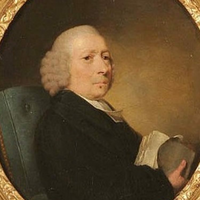
Richard Jago (1 October 1715– 8 May 1781) was an English clergyman poet and minor landscape gardener from Warwickshire. Although his writing was not highly regarded by contemporaries, some of it was sufficiently novel to have several imitators. Life Richard Jago was the third son of the Rector of Beaudesert, Warwickshire, and was named after him. His father’s family was of Cornish origin, while his mother was from the immediately adjoining village of Henley in Arden. He was educated at Solihull School, where one of its five houses is now named after him. While there he formed a lifelong friendship with William Shenstone. In 1732, he went up to University College, Oxford and while there Shenstone made him acquainted with other students with a literary taste. He took his master’s degree 9 July 1738, having entered into the church the year before, and served the curacy of Snitterfield, Warwickshire, near Stratford upon Avon. In 1744, he married Dorothea Susanna Fancourt, daughter of the rector of Kimcote in Leicestershire, whom he had known from her childhood. In 1751 his wife died, leaving him with the care of seven very young children. Three of these were boys, who predeceased him, but he was eventually survived by three of his daughters. In 1759, he married a second wife, Margaret Underwood, but had no children by her. Jago had become vicar of Harbury in 1746, and shortly after of Chesterton, both in Warwickshire. Through aristocratic patrons, he was given the living of Snitterfield in 1754, and later was presented with his former father-in-law’s living in Kimcote in 1771, after which he resigned the livings of Harbury and Chesterton, keeping the others. Snitterfield remained his favourite residence and it was there that he would die at the age of 66. Jago shared with Shenstone an interest in landscape gardening and occupied himself with making improvements to the Snitterfield vicarage garden. Both became part of the likeminded circle about Henrietta Knight, Lady Luxborough which also included other literary friends, William Somervile and Richard Graves, rector of Claverton. Shenstone dedicated a bench to Jago at the end of the viewing circuit near his house, The Leasowes, and both dedicated poems to each other. Poetry Jago’s first independent publications were two sermons. The first, “The Cause of Impenitence Considered” (1755), was published for the benefit of Harbury Free School; the second was a funeral sermon, “The nature and grounds of a Christian’s happiness in and after death” (1763). Shenstone’s letters mention an Essay on Electricity written by Jago, written in 1747, but this seems to have remained unpublished. Poems of his were also beginning to appear in Robert Dodsley’s anthologies, Collection of Poetry by several hands, among which the sentimental elegy “The Blackbirds” had made something of a stir after it first appeared in the ephemeral magazine The Adventurer in 1753. This was a lament on the death of a self-sacrificing blackbird and was shortly followed by similar poems on goldfinches and swallows. They were particularly praised by Dr. John Aikin in his “Essay on the application of Natural History to poetry”, who also noted that there were soon imitations among other minor poets, including Samuel Jackson Pratt’s “The Partridges, an elegy” (1771) and James Graeme’s “The Linnet” (1773). Jago’s most ambitious publication was the four-part topographical poem, Edge Hill, or the rural prospect delineated and moralised (1767). It was written in blank verse and was once described as “the most elaborate local poem in our language”. The poet takes his stance on the hill in the morning, facing south-west (book 1); at noon he is on Ratley Hill in the centre (books 2–3) and then moves along the ridge to look north-east at evening. The poem intermingles description with legendary, historical and antiquarian particulars, principally the battle at the start of the English Civil War. Imaginary excursions are made to Warwick, Coventry, Kenilworth, Solihull, and industrial Birmingham (under the name Bremicham), as well as many “flattering descriptions of all the great houses and seats of important people which come within his survey”. Local rivers are also included and even the nearby canal on which “sooty barks pursue their liquid track”. There are many digressions as well, including descriptions of industrial processes and of the nature of vision and the working of the telescope. The critic already quoted finds the poem “really interesting; with the scene before us, it is impossible not to admire the ingenuity and scrupulous thoroughness with which the author has performed his task,” although ultimately it is lacking in poetic execution. The Cambridge History of English and American Literature judges that "his catalogues have little picturesqueness or colour; while his verse, although it is not without the accent of local association, is typical, as a whole, of the decadence of the Miltonic method of natural description in the 18th century. Every group of trees is a grove, every country house a dome, and every hill a precipice". Particular examples of hackneyed diction include Latin-derived adjectives, as in “Honington’s irriguous meads”, or else 18th century circumlocutions such as “the woolly tribes” when sheep are meant. Nevertheless, the poem seems to have inspired the writing of the much shorter and simpler “Ode to Lansdowne Hill” (1785), which celebrates the site of another Civil War battle. In the following year Jago published “Labour and Genius, or the mill-stream and the cascade”, a humorous fable in octosyllabic verse written in memory of William Shenstone and his landscaped grounds at the Leasowes. Poems of lesser significance appeared here and there and Jago was working on a revised edition of his collected poems just before his death. This appeared posthumously as Poems, Moral and Descriptive in 1784. Included there was another homage to Milton in the oratorio “Adam, or the fatal disobedience, compiled from Milton’s Paradise Lost and adapted to music”. The rhymed choruses there were of Jago’s composition, but the main body of the work is adapted directly from Paradise Lost. Though it found no composer to set it, another of Jago’s pieces did. This was the “Roundelay for the Stratford Jubilee” organised by David Garrick in 1769, which was set for singing by Charles Dibdin. One other humorous piece also found an imitator. In Jago’s “Hamlet’s soliloquy imitated”, a minor poet agonises over whether “to print or not to print” and run the danger, by submitting his verses to Dodsley, to “lose the name of author”. A subsequent parody titled “The Presbyterian parson’s soliloquy” over the question to “conform or not conform” appeared in The Hibernian Magazine in 1774 and was often reprinted thereafter, ascribed to Samuel Badcock. One later commentator gave it as his opinion that “the hint of this parody was probably borrowed from Mr Jago’s”. Slight Jago’s output may have been, but it appears to have been influential in its time. References Wikipedia—https://en.wikipedia.org/wiki/Richard_Jago

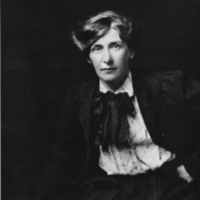
Cicely Mary Hamilton (née Hammill, 15 June 1872– 6 December 1952), was an English actress, writer, journalist, suffragist and feminist, part of the struggle for women’s suffrage in the United Kingdom. She is now best known for the play How the Vote was Won, which sees all of England’s female workers returning to their nearest male relative for financial support.. She is also credited as author of one of the most frequently performed suffrage plays, A Pageant of Great Women (1909), which first put Jane Austen on the stage as one of its “Learned Women.” Biography Cicely Mary Hammill was born in Paddington, London and educated in Malvern, Worcestershire. After a short spell in teaching she acted in a touring company. Then she wrote drama, including feminist themes, and enjoyed a period of success in the commercial theatre. In 1908 she and Bessie Hatton founded the Women Writers’ Suffrage League. This grew to around 400 members, including Ivy Compton-Burnett, Sarah Grand, Violet Hunt, Marie Belloc Lowndes, Alice Meynell, Olive Schreiner, Evelyn Sharp, May Sinclair and Margaret L. Woods. It produced campaigning literature, written by Sinclair amongst others, and recruited many prominent male supporters. Hamilton supplied the lyrics of “The March of the Women”, the song which Ethel Smyth composed in 1910 for the Women’s Social and Political Union. In the days before radio, one effective way to get a message out into society and to have it discussed was to produce short plays that could be performed around the country, and so suffrage drama was born. Elizabeth Robins’s Votes for Women and Cicely Hamilton and Christopher St. John’s How the Vote Was Won are two predominant examples of the genre. Hamilton also wrote A Pageant of Great Women, a highly successful women’s suffrage play based on the ideas of her friend, the theatre director Edith Craig. Hamilton played Woman while Craig played the painter Rosa Bonheur, one of the 50 or so great women in the play. It was produced all over the UK from 1909 until the First World War. Hamilton was a member of Craig’s theatre society, the Pioneer Players. Her play Jack and Jill and a Friend was one of the three plays in the Pioneer Players’ first production in May 1911. During World War I Hamilton initially worked in the organisation of nursing care, and then joined the army as an auxiliary. Later she formed a repertory company to entertain the troops. After the war, she wrote as a freelance journalist, particularly on birth control, and as a playwright for the Birmingham Repertory Company. In 1938 she was given a Civil List pension. Hamilton’s Theodore Savage (1922, vt. Lest Ye Die 1928) is a science-fiction novel about a Britain devastated by a war. In July 2017, the Finborough Theatre staged the first London production of Hamilton’s play 'Just to Get Married’ in over 100 years. It received positive reviews (4 stars) from The Times The Observer The Evening Standard and The New York Times The production was directed by Melissa Dunne and the cast included Tania Amsel, Nicola Blackman, Joanne Ferguson, Lauren Fitzpatrick, Jonny McPherson, Stuart Nunn, Philippa Quinn, Simon Rhodes and Joshua Riley.

